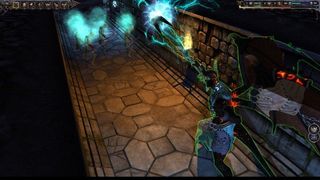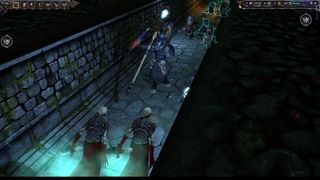Impire hands-on: building a home fit for hellspawn in Cyanide's take on Dungeon Keeper

The nursery in Impire tells you everything you need to know about the game. It's the place you 'birth' your basic monsters. It consists of a raised floor with a wide gutter around the edges. Inside is an imp, stirring a steaming cauldron. Order a new berserker, and the imp puts a few vials into the bubbling stew and *voila* a tattooed warrior imp appears, and runs off to fight. The overspill of the cauldron falls into the full gutter, and there are sad melted imps stuck in it - the failed experiments, I presume. Impire is darkly cute, and aims to bring some fresh elements to Bullfrog's familiar dungeon-building formula.
Impire - like its sister title at Paradox ' Game of Dwarves '- is a Dungeon Keeper clone. Though, it might be fair to say, in the way that the Defence of the Ancients clones have called themselves MOBAs, that Dungeon Keeper has become a genre these days. Set in the world of Ardania, from the Majesty games, Impire is an unholy experiment in combining dungeon management, RTS, and RPG. “We assembled a brand new team in Montreal, just for this game. We're huge fans of Dungeon Keeper, but we're trying to add something new to the genre.” says Yves Bordeleau, Director of the new Montreal studio.
You play a diminutive imp, whose fragile frame actually contains the spirit of a Baal-Abaddon, a ten foot tall demon summoned by an incompetent sorceror, Oscar Van Fairweather. “He's a quack and you're quite pissed off about that.” The apologetic Oscar still wants to dominate the world, and your task is to aid him. “After a while, you want to break the hold that Oscar has over you.”

The dungeon management part is the most familiar. Your imps tunnel through the soil and construct chambers for you. Unlike Dungeon Keeper, these are all hand-crafted, and so require particular shapes. The rooms vary from the mushroom-crammed fungi farm, to Indiana Jones style storerooms, a gruesome kitchen (full of human ramen and other ick dishes, to heal your troops), the forge (where you can make new weapons, armour, and traps) and the Dive (a bar where you can hire non-Impish units like the Warlock).
As you build rooms, the evil level of your dungeon increases, attracting heroes. These enemies of all this evil and wrong enter your dungeon to attack your chambers and minions - at which point your imps can be told to scurry along and repaid the rooms by... doing a dance from Fantasia, that rewinds time. (Disney can't have copyrighted a dance, right?)
Where this differs is that your minions get to assault the overworld too. Looking at the cutesy overworld map, there are icons for raiding for treasure, food, materials and quests. Like Evil Genius, you can send your troops off to locations on the surface for specific mission objectives. Surface combat takes place in surface locations, like villages and dig sites. But it's best to send a squad.

“We have a squad-based system, a bit like Dawn of War II.” There's a context-sensitive menu that makes it easy to command your units - clicking a berserker lets us see that he can be ordered to eat, train, patrol, attack, teleport (as a quick way of getting around the dungeon, like Dungeon Keeper's picking up). Once you've formed a squad from your troops, they all share the characteristics of the individuals in the squad - so a squad with a warlock, berserker and scout in, can go into a berserk mode, debuffs heroes and has easier criticals. Making custom squads for different situations makes sense.
PC Gamer Newsletter
Sign up to get the best content of the week, and great gaming deals, as picked by the editors.
Moreover, Cyanide is including a co-operative campaign and 4-player multiplayer. Players each have their own dungeon, but abut a shared battlefield, in a weird combination of the Dungeon Lords boardgame and Dwarf Fortress. The team hasn't decided what sort of games you can play on this, but they'll they're pondering Capture-The-Flag, Tower Defense and King of the Hill modes.
Multiplayer also splits the creatures into the Fiends, consisting of monsters and creatures, and the Souless, consisting of demons and the undead. For the latter, they also have completely different minions (zombie imps), rooms and a different tech tree. Their rooms are worthy of note - the sacrifice room lets you heal some units by killing others, the extractor grinds up heroes and harvest their souls, the brewery lets heroes drink themselves stupid, the prison lets you trap heroes for ransom, the arcanium lets you create magical armour and weapons, and the monster den summons random monsters.

As you go along, you can customise your Demon overlord, using cards you've found in the game, as well as bought from an in-game boutique. “You can buy card stacks, new skins, DLC and so on. Obviously, we're not going towards the evil boutique - nothing that overpowers the gameplay experience.” As we upgrade the demon lord, he starts looking less and less like an imp - his wings grow, say, or his skin gets super-tough. He can specialise in one of three trees, as he levels - warrior, commander or mage. Similarly, as you complete in-game achievements, like digging a hundred metres, you get tech points, which allows you to customise how you play the game - unlocking new units, such as female warlocks and imp scouts (archers), or more rooms, or other goodies.
I'm really quite impressed by how much work Cyanide Montreal has already put into this game. It's still pre-Alpha, but it already looks playable now, and seems packed full of in-jokes and gorgeous design. It'll be out in early 2013.
Most Popular




